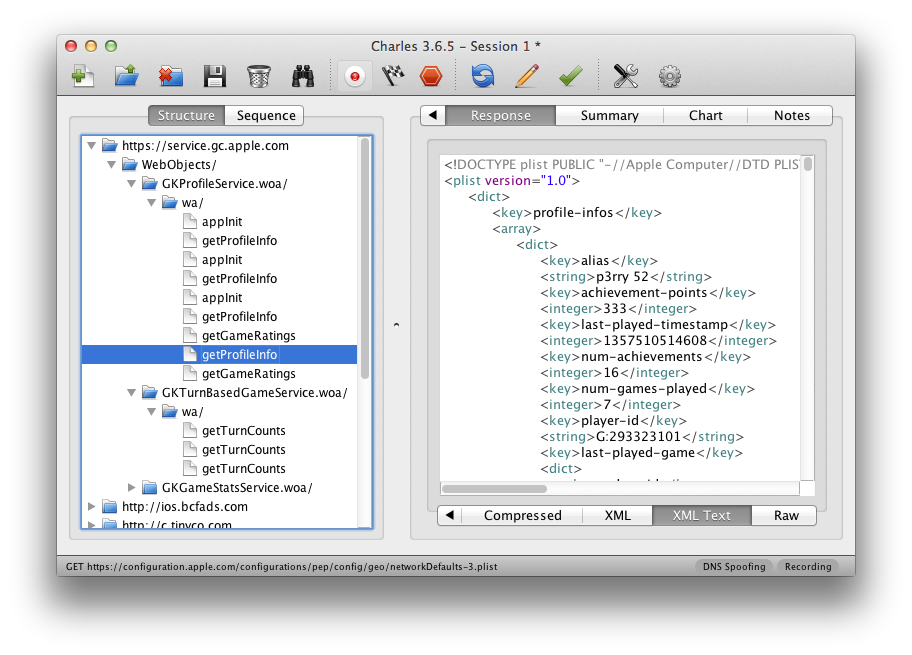Yesterday I was in the situation where I wanted to debug an iOS deviceand what network calls it would make. Normally the trivial step is tojust define an HTTP proxy server in the wifi settings but that will onlywork for as long as you have
Yesterday I was in the situation where I wanted to debug an iOS device and what network calls it would make. Normally the trivial step is to just define an HTTP proxy server in the wifi settings but that will only work for as long as you have something that actually honors this proxy server. But there are better ways to transparently proxy connections from a device connected via Wifi which does not require any changes on the actual device.
The Tools
In order for this to work you need a device running OS X which is connected to the same network as the Wifi. Then you need to convince the Wifi device to see you as the gateway instead of the actual gateway. The easiest way is just to go to the settings and change the gateway to your computer's IP. The second ingredient is an HTTP proxy, ideally one that can also decrypt and reencrypt SSL traffic. Personally I can recommend Charles for that. Lastly you will need another proxy that can work transparently which sits between your device and Charles. On OS X redsocks gets this job done.
If you don't want to spend the money on Charles or you want to rewrite traffic with Python you can use mitmproxy.
The Setup
The first thing you will notice is that when you point your Wifi device to your computer it will loose network connectivity. That's because by default your computer won't forward packets. This can easily be changed through sysctl:
$ sudo sysctl -w net.inet.ip.forwarding=1
After that you should be able to browse the internet again on your Wifi device.
The second step is installing redsocks. If you have brew that's a very trivial operation:
$ brew install redsocks
Once installed you will need to create a config file for it. Call it redsocks.conf and place it in a folder from which you run redsocks:
base {
log_debug = on;
log_info = on;
log = stderr;
daemon = off;
redirector = generic;
}
redsocks {
local_ip = 0.0.0.0;
local_port = 12345;
ip = 127.0.0.1;
port = 8889;
// known types: socks4, socks5, http-connect, http-relay
type = socks5;
}
Since I'm using Charles I take advantage of it's socks5 support and point it to localhost:8889 where Charles normally starts up if configured as Socks5 proxy. If you're using a regular HTTP proxy you can use http-connect as proxy type. The local_port defines where the actual transparent redsocks proxy opens.
All you have to do then is to start it:
$ redsocks
After that you will need to point all the traffic that is not from your computer and from port 80 and 443 of your Wifi through redsocks. On OS X the firewall canbe controlled through ipfw. In my case the wifi device is en1:
$ sudo ipfw add fwd 127.0.0.1,12345 tcp from not me to any 80 in via en1 $ sudo ipfw add fwd 127.0.0.1,12345 tcp from not me to any 443 in via en1
Working around OS X Bugs
Now currently if you finish that above setup you will notice that nothing actually works. The cause for this is a Bug in the OS X kernel that requires flipping the net.inet.ip.scopedroute flag to 0. I am not entirely sure what it does, but the internet reports that it breaks network sharing through the user preferences. In any case it fixes ipfw based forwarding so you can flip it with sysctl:
$ sudo sysctl -w net.inet.ip.scopedroute=0
Unfortunately in OS X Lion this flag can actually not be flipped from userspace so you need to set it as boot parameter and then restart your computer. You can do this by editing the /Library/Preferences/SystemConfiguration/com.apple.Boot.plist file:
<?xml version="1.0" encoding="UTF-8"?> <plist version="1.0"> <dict> <key>Kernel Flags</key> <string>net.inet.ip.scopedroute=0</string> </dict> </plist>
Installing SSL Certificates
After all that your HTTP traffic should show up in your SSL interception proxy. SSL will only work if the application on your Wifi device is trusting your SSL interception proxy's CA. For browsers for instance that's trivial to change. The Charles Certificate can be added to the trust store by following this link: charles.crt. Note that this will not work with applications that don't use the system's CA trust store. In that case you will need to recompile your application so that it trusts the Charles CA.

原文地址:OSX as Transparent Wifi MITM Proxy, 感谢原作者分享。
 MySQL:世界で最も人気のあるデータベースの紹介Apr 12, 2025 am 12:18 AM
MySQL:世界で最も人気のあるデータベースの紹介Apr 12, 2025 am 12:18 AMMySQLはオープンソースのリレーショナルデータベース管理システムであり、主にデータを迅速かつ確実に保存および取得するために使用されます。その実用的な原則には、クライアントリクエスト、クエリ解像度、クエリの実行、返品結果が含まれます。使用法の例には、テーブルの作成、データの挿入とクエリ、および参加操作などの高度な機能が含まれます。一般的なエラーには、SQL構文、データ型、およびアクセス許可、および最適化の提案には、インデックスの使用、最適化されたクエリ、およびテーブルの分割が含まれます。
 MySQLの重要性:データストレージと管理Apr 12, 2025 am 12:18 AM
MySQLの重要性:データストレージと管理Apr 12, 2025 am 12:18 AMMySQLは、データストレージ、管理、クエリ、セキュリティに適したオープンソースのリレーショナルデータベース管理システムです。 1.さまざまなオペレーティングシステムをサポートし、Webアプリケーションやその他のフィールドで広く使用されています。 2。クライアントサーバーアーキテクチャとさまざまなストレージエンジンを通じて、MySQLはデータを効率的に処理します。 3.基本的な使用には、データベースとテーブルの作成、挿入、クエリ、データの更新が含まれます。 4.高度な使用には、複雑なクエリとストアドプロシージャが含まれます。 5.一般的なエラーは、説明ステートメントを介してデバッグできます。 6.パフォーマンスの最適化には、インデックスの合理的な使用と最適化されたクエリステートメントが含まれます。
 なぜMySQLを使用するのですか?利点と利点Apr 12, 2025 am 12:17 AM
なぜMySQLを使用するのですか?利点と利点Apr 12, 2025 am 12:17 AMMySQLは、そのパフォーマンス、信頼性、使いやすさ、コミュニティサポートに選択されています。 1.MYSQLは、複数のデータ型と高度なクエリ操作をサポートし、効率的なデータストレージおよび検索機能を提供します。 2.クライアントサーバーアーキテクチャと複数のストレージエンジンを採用して、トランザクションとクエリの最適化をサポートします。 3.使いやすく、さまざまなオペレーティングシステムとプログラミング言語をサポートしています。 4.強力なコミュニティサポートを提供し、豊富なリソースとソリューションを提供します。
 InnoDBロックメカニズム(共有ロック、排他的ロック、意図ロック、レコードロック、ギャップロック、次のキーロック)を説明します。Apr 12, 2025 am 12:16 AM
InnoDBロックメカニズム(共有ロック、排他的ロック、意図ロック、レコードロック、ギャップロック、次のキーロック)を説明します。Apr 12, 2025 am 12:16 AMINNODBのロックメカニズムには、共有ロック、排他的ロック、意図ロック、レコードロック、ギャップロック、次のキーロックが含まれます。 1.共有ロックにより、トランザクションは他のトランザクションが読み取らないようにデータを読み取ることができます。 2.排他的ロックは、他のトランザクションがデータの読み取りと変更を防ぎます。 3.意図ロックは、ロック効率を最適化します。 4。ロックロックインデックスのレコードを記録します。 5。ギャップロックロックインデックス記録ギャップ。 6.次のキーロックは、データの一貫性を確保するためのレコードロックとギャップロックの組み合わせです。
 貧弱なMySQLクエリパフォーマンスの一般的な原因は何ですか?Apr 12, 2025 am 12:11 AM
貧弱なMySQLクエリパフォーマンスの一般的な原因は何ですか?Apr 12, 2025 am 12:11 AMMySQLクエリのパフォーマンスが低いことの主な理由には、インデックスの使用、クエリオプティマイザーによる誤った実行計画の選択、不合理なテーブルデザイン、過剰なデータボリューム、ロック競争などがあります。 1.インデックスがゆっくりとクエリを引き起こし、インデックスを追加するとパフォーマンスが大幅に向上する可能性があります。 2。説明コマンドを使用してクエリ計画を分析し、オプティマイザーエラーを見つけます。 3.テーブル構造の再構築と結合条件を最適化すると、テーブルの設計上の問題が改善されます。 4.データボリュームが大きい場合、パーティション化とテーブル分割戦略が採用されます。 5.高い並行性環境では、トランザクションの最適化とロック戦略は、ロック競争を減らすことができます。
 複数の単一列インデックスに対して複合インデックスをいつ使用する必要がありますか?Apr 11, 2025 am 12:06 AM
複数の単一列インデックスに対して複合インデックスをいつ使用する必要がありますか?Apr 11, 2025 am 12:06 AMデータベースの最適化では、クエリ要件に従ってインデックス作成戦略を選択する必要があります。1。クエリに複数の列が含まれ、条件の順序が固定されている場合、複合インデックスを使用します。 2。クエリに複数の列が含まれているが、条件の順序が修正されていない場合、複数の単一列インデックスを使用します。複合インデックスは、マルチコラムクエリの最適化に適していますが、単一列インデックスは単一列クエリに適しています。
 MySQLでスロークエリを識別して最適化する方法は? (スロークエリログ、Performance_schema)Apr 10, 2025 am 09:36 AM
MySQLでスロークエリを識別して最適化する方法は? (スロークエリログ、Performance_schema)Apr 10, 2025 am 09:36 AMMySQLスロークエリを最適化するには、slowquerylogとperformance_schemaを使用する必要があります。1。LowerQueryLogを有効にし、しきい値を設定して、スロークエリを記録します。 2。performance_schemaを使用してクエリの実行の詳細を分析し、パフォーマンスのボトルネックを見つけて最適化します。
 MySQLおよびSQL:開発者にとって不可欠なスキルApr 10, 2025 am 09:30 AM
MySQLおよびSQL:開発者にとって不可欠なスキルApr 10, 2025 am 09:30 AMMySQLとSQLは、開発者にとって不可欠なスキルです。 1.MYSQLはオープンソースのリレーショナルデータベース管理システムであり、SQLはデータベースの管理と操作に使用される標準言語です。 2.MYSQLは、効率的なデータストレージと検索機能を介して複数のストレージエンジンをサポートし、SQLは簡単なステートメントを通じて複雑なデータ操作を完了します。 3.使用の例には、条件によるフィルタリングやソートなどの基本的なクエリと高度なクエリが含まれます。 4.一般的なエラーには、SQLステートメントをチェックして説明コマンドを使用することで最適化できる構文エラーとパフォーマンスの問題が含まれます。 5.パフォーマンス最適化手法には、インデックスの使用、フルテーブルスキャンの回避、参加操作の最適化、コードの読み取り可能性の向上が含まれます。


ホットAIツール

Undresser.AI Undress
リアルなヌード写真を作成する AI 搭載アプリ

AI Clothes Remover
写真から衣服を削除するオンライン AI ツール。

Undress AI Tool
脱衣画像を無料で

Clothoff.io
AI衣類リムーバー

AI Hentai Generator
AIヘンタイを無料で生成します。

人気の記事

ホットツール

MinGW - Minimalist GNU for Windows
このプロジェクトは osdn.net/projects/mingw に移行中です。引き続きそこでフォローしていただけます。 MinGW: GNU Compiler Collection (GCC) のネイティブ Windows ポートであり、ネイティブ Windows アプリケーションを構築するための自由に配布可能なインポート ライブラリとヘッダー ファイルであり、C99 機能をサポートする MSVC ランタイムの拡張機能が含まれています。すべての MinGW ソフトウェアは 64 ビット Windows プラットフォームで実行できます。

SAP NetWeaver Server Adapter for Eclipse
Eclipse を SAP NetWeaver アプリケーション サーバーと統合します。

メモ帳++7.3.1
使いやすく無料のコードエディター

Dreamweaver Mac版
ビジュアル Web 開発ツール

SublimeText3 Linux 新バージョン
SublimeText3 Linux 最新バージョン







